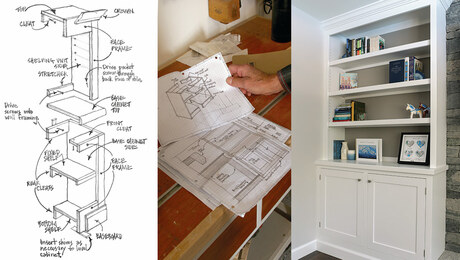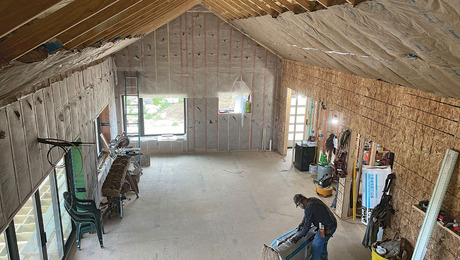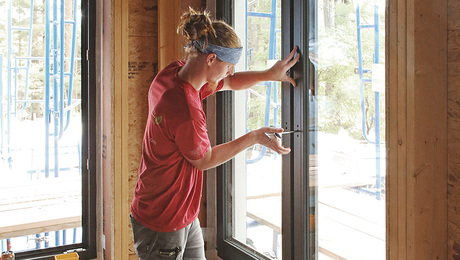Podcast 467: Crawlspace Ductwork, Heat-Pump Hydronic Heating, and Unconditioned Basement Rooms
Andrew, Ian, and Patrick hear from listeners about termites and heat pumps before taking questions about hot attic living space, using fiberglass reinforced panels (FRP) for sheathing, and bringing underporch rooms into the thermal envelope.
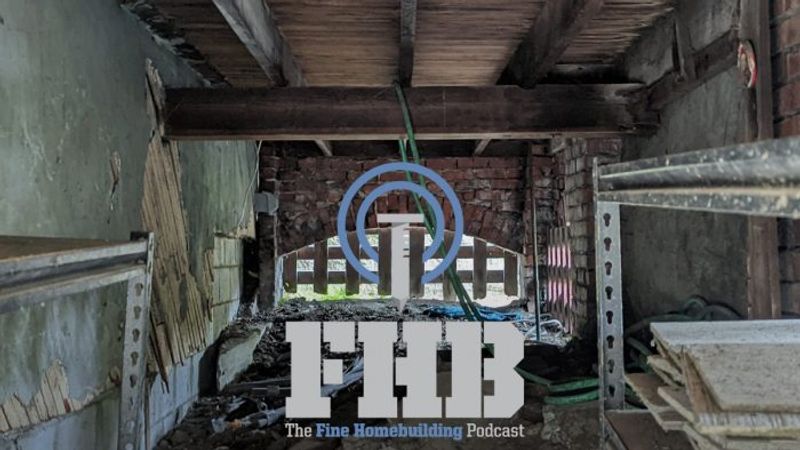
Follow the Fine Homebuilding Podcast on your favorite app. Subscribe now and don’t miss an episode:
 |
Help us make better episodes and enter for a chance to win an FHB Podcast T-shirt:
www.finehomebuilding.com/podcastsurvey
Keith has thoughts on unintended consequences from weatherization work. Barbara and Nathan share their experiences with termites. Andrew reminds us to right-size heating and cooling equipment. Jackie asks how to keep her attic bedroom cool. Nate wants to update his HVAC system and keep his baseboard radiators. Wade wonders if he can use FRP panels to sheath his new garage. James asks Andrew for help bringing his underporch room into his home’s thermal envelope.
Editor Updates:
- Andrew’s blower door test
- Ian’s screen porch
- Jeff’s exhaust system repairs
- Patrick’s photo shoot in NC
 |
 |
 |
 |
 |
 |
Listener Feedback 1:
Keith Bohling writes: Patrick, In episode 459, I’m glad that you read the letter from Steve in New Jersey about his moldy attic ladder after his energy upgrade from a state efficiency program. Contractors performing energy efficiency upgrades must be aware of the possible unintended consequences of the work they perform. In a heating climate like New Jersey, a cold roof and cold attic dictate that the air and vapor control layers be as close to the warm side of a ceiling assembly as possible. For Steve and anyone else who has work done through a utility or state energy office program, there is an escalation path when issues arise. Most, if not all, program administrators utilize some sort of quality assurance and/or field technical support. It’s usually possible to contact the program manager, explain what happened, and request a follow-up evaluation or inspection. If poor quality work is observed, the original contractor or a replacement contractor will usually remediate it. Additionally, the observations from the follow-up evaluation or inspection are usually fed into a feedback loop to the original contractor. If the program administrators see recurring issues, they are likely to adjust training, contractor support, and/or procedures to head off future problems. I’d encourage anyone who has an issue with a program installation to reach out to the original contractor first and if the issue isn’t resolved, contact the program management.
Listener Feedback 2:
Barbara writes: Hello podcast friends, I just finished listening to the podcast (#461) with questions about termites and insulating under a raised floor. You wanted to hear more about termites? I got you. I had a termite swarm emerge in my tiny house last year. I made a video about how I dealt with it. It goes into termite habits and how exactly they made their way to the edible parts of my house. I got macro shots of them and everything.
Termites can’t eat Advantech. I kind of assumed Zip sheathing was equally impervious. Is that not the case? I do remember being surprised by the YouTube video of Matt Risinger spraying a blue borate solution halfway up the inside of his walls before he put in the rockwool or whatever he used in that insane ice chest of a house he just built.
After I took care of the termites, I worked on my very low R-value insulation under my house. I built my house the perfect height above the ground for working underneath it fairly comfortably as a full-grown adult. No toddlers on my crew.
I could write an article for you about termites, but I am not sure my experience is very relevant to normal people. I have done a lot of research. It seems the poison and detection side of it is mostly about protecting the investment of whoever holds the mortgage. If you own your house outright the pest control people don’t even try to sell you a termite treatment contract. I thought about you, Patrick, when I was under the house yanking down insulation with termites raining down on my hat. Your worst nightmare? There were some top-notch spiders under there too.
Related Links:
- How to Prevent Termite Infestation Using Stainless Steel
- Rigid Mineral Wool Foundation Insulation Review
Listener Feedback 3:
Nathan in Kansas City, writes: Hi all, I listened to this week’s podcast, episode 461, and it was mentioned that the amount of wood in a typical house was not enough to support the building of a nest for a whole colony. I am writing from the Kansas City area where termites have always been a problem. I have been helping a friend that bought this house 3 weeks ago and it was noted by the inspector that there was some termite damage in the finished basement. The basement is a walk out with the whole back of the house stick built off the footings that are at grade level. It was much more than some.
But the reason I am writing is to send these pictures of what was an entire condo development worth of nest. The largest part was under the lower platform of the built-in bar and at least half of it fell apart when I pulled the platform from the floor. Even the veteran exterminator was amazed by its size and scope.
 |
 |
 |
A treatment was performed before close around the parameter of the house. Now that there is access to the framing and the concrete slab, the exterminator has used a spray foam on the worst areas and drilled through the slab to treat under it as well.
Love the show, keep up the good work
Listener Feedback 4:
Andrew in Annapolis, MD, writes: Greetings podcast team, Long time listener, first time writer here. I’m responding to the listener (Adam) debating replacing his furnace with a heat pump in episode 459. As an employee of one of the major HVAC manufacturers I feel there are two major points missing from this and other discussions of its type.
First, the BTU ratings on HVAC equipment are a measurement of energy over time. His current furnace consumes 100,000 BTUs of gas per hour and converts it to heat. To a certain degree slight downsizing would only result in longer runtime. The system would still maintain the same temperature indoors. Increased runtime actually improves comfort as it reduces humidity in the summer and maintains more even heat in the space in the winter.
Second, the vast majority of residential HVAC systems in the U. S. are oversized to begin with, especially in older homes like his when they were first built and/or converted from coal or oil. (Contractors used to stand across the street and see how many fingers would cover the house – 2 fingers/2 tons, 3 fingers/3tons, etc.) Fast forward several decades of each contractor just replacing what was there with identical capacity, meanwhile efficiency has been increasing, and even before his insulating project this listener’s system is probably oversized.
My advice would be to partner with a local HVAC company willing to do the manual J, manual D, and other calculations needed to properly size his system before and after his projects. This sounds like the perfect opportunity for a dual fuel system utilizing a high-efficiency two-stage gas furnace inside coupled with a variable capacity heat pump outside. This would use the heat pump efficiency for the bulk of his heating needs and would still use the gas furnace for backup and during extremely low outside temperature instead of electrical resistance heat strips. It also takes in to account the eventual reduction in heating and cooling loads due to his impending insulation and air sealing improvements. The indoor coil is the same, the only increase in cost would be in the outdoor unit being a heat pump over a traditional AC condenser – a matter of a few thousand dollars max. All the major manufacturers now have variable capacity split heat pumps which no longer require expensive proprietary communicating controls.
Love the podcast, keep it up. Thanks.
Related Links:
Question 1: How do I cool an attic bedroom in a dormerless cape?
Ian (Jackie) in Madison writes: Podcast Crew, Attached is my crude sketch up of the existing condition and a photo of Jackie’s house in Madison. (In true Joe Lstibruek fashion I have chosen to depict the insulation layer as pink but if the blue insulation company would like to pay me more, I am open to change)
 |
 |
Here is what I know and what I think I know.
• The house is a dormer-less cape. (Ripe for a GREEDY dormer addition IMHO. Patrick, I think you would agree)
• The attic space shown on the drawing is the primary bedroom in the house.
• Sleeping in the bedroom is not an issue during the winter. Cold sleeping preferences and a wood stove make it work.
• Sleeping in the bedroom during summer is an issue. Very Hot.
• The furnace was replaced last month with a new dual fuel heat pump unit that has AC.
• The bedroom has a chimney running up the center. It has been taken down below the roof. Jackie plans to remove it from the bedroom to run ductwork up for AC.
• The lid and the knee walls of the space are insulated with R19 fiberglass batts. No real air sealing beyond the drywall interior.
• The roof has a ridge vent but the house does not have much for overhangs to draw and air in for venting. The gable ends are not vented.
• The day that I visited the house it was high 60s/low 70s and sunny. The temp inside the space behind the knee was warm but not surprisingly so. The temp above the lid was very hot.
• Given that, contrary to popular belief, heat does not “rise” it moves from warm to cold just as moisture moves from wet to dry, I hypothesize that the unvented triangle of space above the ceiling of the attic bedroom is cooking the inhabitants below broiler style.
• My thought given that this space is hard to access and that we would like to start with low tech DIY options, is to add some roof vents in the field of the roof in an attempt to create some convection for the ridge vent to pull the hot air out. And then blow in some additional cellulose via the existing small scuttle opening and the opening that will be created by removing the chimney.
Looking forward to discussing.
Related Links:
- Venting a Tricky Old Roof
- Attic-Ventilation Strategies
- Insulating Behind Kneewalls
- Redesigning a Cramped Attic Space
Question 2: Does anyone ever install a heat pump and use it to heat a storage tank of water that is circulated through the existing baseboards?
Marc in Hunter NY writes: Hi FHB podcast crew! Love the show, thanks for the quality content.
My question is in the same vein as some you’ve tackled recently, i.e. replacing a furnace/boiler with a heat pump. But I can’t recall any discussion of the following: with perfectly good hydronic baseboards all over the house, it seems a waste to use mini split or ducted systems when upgrading to a heat pump. Does anyone ever install a heat pump and use it to heat a storage tank of water that is circulated through the existing baseboards? I know preference for hydronic vs forced air can be kind of a personal issue, but I quite like the kind of heat the baseboard radiators give us.
So, is this simply not done for some reason? My bet is that the electricity needed to run the circulator makes this a bad approach, is that the case? Perhaps one can’t get the water hot enough for radiators with a heat pump? Also, if you chilled the water in the winter and ran it through the rads, do you think you’d get any meaningful cooling? As I’m sure you’ve guessed, this question is inspired by my 90s oil burning furnace, the slightly sketchy tank feeding it, and my desire to move away from fossil fuels if I can.
Thanks for the show!
Related Links:
Question 3: Can I use FRP panels to sheathe my garage walls?
Wade K. in South Dakota writes: Hey FHB CREW, Writing in to pick your brain on a building detail I’ve never come across before. I’m building a 2-story, 30×50 garage with living space above. Details are 2×6 walls and am thinking 2-3″ of spray foam then fill the rest with batt insulation on the inside. Outside cladding will be horizontal 8″ LP Siding. My question is concerning the sheathing. I have a contractor friend who will be helping me with the build and happens to have a rather large stock of a combination of OSB and plywood sheathing that has an FRP panel (fiberglass reinforced panel) glued to it. I am thinking of using those for all exterior walls, as well as the interior walls of the shop portion. Having never seen this detail before, could one tape all seems with flashing tape (thinking ZIP)? Would that suffice as a WRB, or would adding housewrap also be required? What issues do you see that I may be missing? I’m in South Dakota, climate zone 6, and am concerned about condensation forming between the panels and the siding. The shop portion does have in-floor heat in a 5″ insulated slab. Any questions, please reach out. Thanks for your help!
Related Links:
Question 4: Does it make sense to include the area underneath the porch inside the building envelope as we remodel our basement and if so, what should the details of the roof be?
James writes: Hey podcast crew, I recall Andrew mentioning that he has a room underneath a porch at his house and I’d love to learn more about it because I’m trying to figure out what to do with the front porch of our house when we remodel the basement. Our lot has a 13% grade and we’re hoping to underpin the foundation such that the new basement floor will be level with the highest point of our driveway, giving us more basement ceiling height and allowing us to add a grade-level entrance on the driveway. As we’re working out our plans, I’ve been puzzling over what we should do with the area underneath the front porch.
 |
 |
 |
 |
The front porch has quite a few idiosyncratic elements that I suspect might be common from homes of its era (1912):
• It’s entirely covered by a finished attic space
• The central beam of the house extends to the front of the porch and is supported by the concrete steps
• The side rim joists extend past the front foundation wall to the front of the porch
• The joists of the porch run parallel to the house and rest upon the central beam
• There is no ledger board. Instead, the tails of the subfloor boards extend beyond the front wall and the porch floorboards rest upon it
Effectively, the porch is an extension of the house’s floor system that happens to be outdoors. The floor system in the overhanging attic is similar. It seems like we have all the structural elements for the porch to be part of the house. All that’s missing is the walls!
The front foundation wall seems like a lost cause because it looks like a foundation, but it’s mostly freestanding. It provides support for the central beam, but sits 2 inches behind the rim joist. It’s built out of CMUs and flexes when you push on it. Since I doubt that wall would survive underpinning, the question I’m left with is: does it make sense to include the area underneath the porch inside the building envelope? If we did that, what would the details for its roof look like? Could we put a low-sloped roof below the beam? I’d love to hear more about how Andrew’s is built since just about everything he’s said about his house sounds like mine and I’m curious to see if whoever built that room might have done some problem solving around similar conditions. I’ve attached some photos. Feel free to share them on the podcast if you’d like to. Thanks!
Andrew’s porch basement:
 |
 |
 |
 |
Related Links:
END NOTES:
How to Hire and Retain Good Tradespeople by Ian Schwandt
Check out one of our Project Guides: Siding & Exterior Trim!
Check out our FHB Houses:
Visit the Taunton Store • Magazine Index • Online Archive • Our First Issues • All Access
Help us make better episodes and enter for a chance to win an FHB Podcast T-shirt: www.finehomebuilding.com/podcastsurvey

If you have any questions you would like us to dig into for a future show, shoot an email our way: [email protected].
If we use your question we’ll send you a FHB Podcast sticker!
FHB Podcast T-shirts!
Represent your favorite podcast! Available in several styles and colors. Made from 100% cotton. Find the Podcast t-shirt and more cool products in the Fine Homebuilding Store.
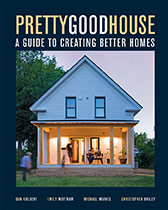
Fine Homebuilding podcast listeners can now get 20% off anything in the Taunton store, including Pretty Good House.
Use the discount code FHBPODCAST to take advantage of this special offer.
We hope you will take advantage of a great offer for our podcast listeners: A special 20% off the discounted rate to subscribe to the Fine Homebuilding print magazine. That link goes to finehomebuilding.com/podoffer.
The show is driven by our listeners, so please subscribe and rate us on iTunes or Google Play, and if you have any questions you would like us to dig into for a future show, shoot an email our way: [email protected]. Also, be sure to follow Fine Homebuilding on Instagram, and “like” us on Facebook. Note that you can watch the show above, or on YouTube at the Fine Homebuilding YouTube Channel.
The Fine Homebuilding Podcast embodies Fine Homebuilding magazine’s commitment to the preservation of craftsmanship and the advancement of home performance in residential construction. The show is an informal but vigorous conversation about the techniques and principles that allow listeners to master their design and building challenges.
Other related links
-
- All FHB podcast show notes: FineHomebuilding.com/podcast.
- #KeepCraftAlive T-shirts and hats support scholarships for building trades students. So order some gear at KeepCraftAlive.org.
- The direct link to the online store is here.









